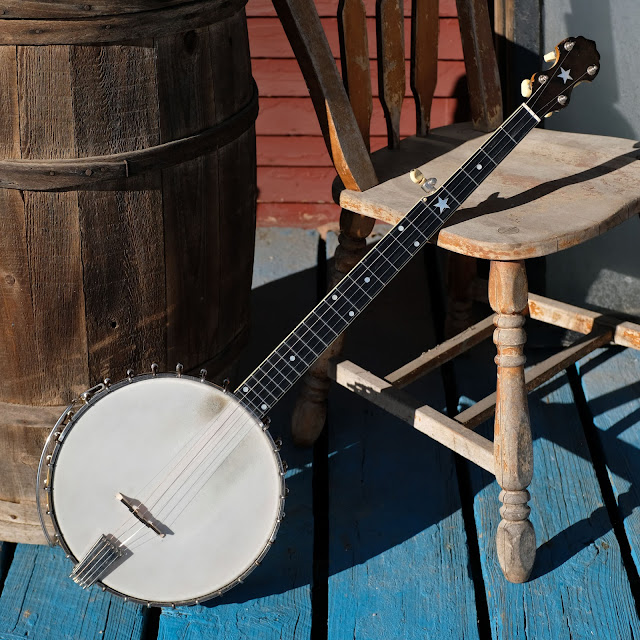1920 Vega Fairbanks Whyte Laydie No. 2 Openback 5-String Banjo
It's not every day one sees an original Vega 5-string from this era. Most "Vega" 5-strings of this time are reproduction necks mated to tenor-banjo rims bearing the same, coveted, Whyte Laydie ring. The reason? Well -- because tenor banjos were far more popular at that point. We have completely the inverse of that production these days, but if the records for Vega are roughly the same as for Gibson, the 5-strings built in the '20s were way down the totem pole in build numbers. This is the reason wanting a "Vega Whyte Laydie 5-string" has become somewhat synonymous with the quest for a high-quality, hard-to-find, old-time banjo.
All that superfluity aside, this really is a nice old instrument. The Whyte Laydie and Tubaphone tonerings employed by Vega tend to have a clear, projecting, and focused voice that is also mellow at the same time, and the rest of the specs on the banjo -- hard maple used throughout construction with a thick, multi-ply rim and heavy-duty hardware -- add to that sound in their own ways.
This banjo has come in for consignment and it arrived almost ready to go. It came in all-original and very clean save a replacement set of older geared tuners (capped with what seem to be the original ivoroid buttons), a replacement bone nut, a Remo frosted-top head, and a replacement bridge. My work included a fret level/dress job, cleaning, and proper setup for 1/16" action height overall at the 12th fret with a nice, tall, 5/8" compensated bridge. I have it strung with 9s to keep the neck happy and it sounds tops and plays beautifully.
Specs include a 27" scale, 1 3/16" nut width with 1" string spacing at the nut and 1 11/16" spacing at the bridge, and an 11" head. The neck has a medium, soft-V profile on the back and a flat-profile fretboard. The instrument is made entirely from maple (even the ebonized headstock veneer) except for the fretboard which is ebony. As usual for this type, there's double-banding of tortoise celluloid on the inside of the rim and one on the outside and the shoes are all set into a bracket band that serves to also reinforce the rim.
Pearl star inlay never hurts.
Someone installed the 5th-string geared peg with an interesting pinned-in job. That's how they managed to let it remain farther out from the neck than normal but still stable. It's in there pat which is why I didn't remove it and put it in a little deeper. Note that the original bone "pip" for the 5th string is still extant and someone installed railroad spikes at 5th-string frets 2 and 4, too.
An adjustable tailpiece that accepts loop, knot, and ball-ends is nice to have, too.
There are indications at the dowel and at the side of the heel that a resonator might've been on this at some point -- whether it was aftermarket or not is simply something we'll never know.
The serial numbers match and suggest 1920 manufacture.
There's that WL tonering.
Gorgeous, right? It's shocking to see all the hardware in such good order.
An older, hard, brown-colored case comes with it.






























Comments
Either 20097 with an upside down 2, or 16002 with an inverted 7 used as a 1... and the winner is... thanks to your pic ... 20097 with inverted 2.
http://hschwartz.com/FairbanksBanjos/Serialnumbers.html
Thanks,
Gary